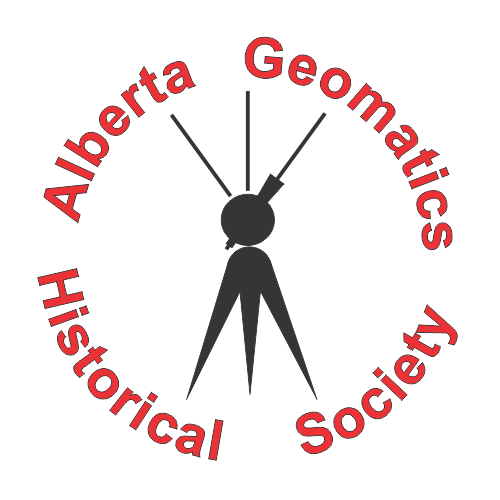
35. The Competition Heats Up – More EDMs
By Gordon Olsson
EDM (Electronic Distance Measurement) was introduced to the surveying community in the late 1950s and early 1960s by Tellurometer (See article 33: The Skill of Chaining would be lost – The Tellurometer) and AGA Geodimeter (See article 34: Measuring by the Speed of Light – The Geodimeter). This new technology captured the interest of many other companies in the surveying instrument business. In 1965, a symposium was held in Oxford, UK on EDM development. In the exhibit hall, four Tellurometer models and the Model 6 Geodimeter were on display. In addition, there was a Laser Rangefinder from G. & E. Bradley Ltd of London, a Mekometer from Hilger and Watts Ltd of London, a Wild Distomat DI 50, the E.O.S. Telemeter of C. Z. Scientific of London, an Ordnance Survey Thermistor from the UK Ordnance Survey in Surrey, and a NPL Mekometer II from the National Physical Laboratory in Middlesex. In the following years, other companies jumped on the bandwagon and produced EDMs including the Cubic Corporation of San Diego, California, Hewlett Packard, K&E and several years later Sokkisha.
The early EDMs were large and heavy and powered by even heavier batteries, initially being 12-volt car batteries. They were not economical or practical for subdivision work or for most township survey work because of their weight and because topography along the line had to be tied in. Their advantage was in measuring long distances over difficult terrain and for control surveys. Later EDMs were smaller, had lighter batteries and were designed so they could be mounted on theodolites. As time went by, the smaller, lighter, most functional, most accurate, most economical and best marketed EDMs prevailed. Within a few years, many makes of EDMs were discontinued or the companies that produced them went bankrupt or were taken over by other companies.
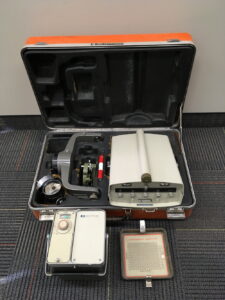
HP3800A. Hewlett-Packard moved into the EDM market in 1969. The HP 3800A Distance Meter was introduced in 1970. It was popular amongst land surveyors as taking measurements with it was comparatively quick. It used a beam of infrared light to measure distances up to two miles with an accuracy of one part in 100,000. It was ideal for a large amount of land surveying work. It had a separate power unit (shown at the bottom left corner in the image). Hewlett-Packard advertised in 1973 that there were over 2500 HP Distance Meters in use in the USA and Canada, more than that of all other competitors put together. Around the turn of the 20th century Hewlett-Packard divested itself of surveying instruments.
Donated by Jack (Bev) Cheetham, ALS#451
ALSA 2016.04.02
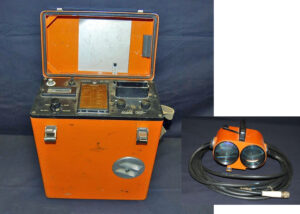
Wild DI 10 Distomat. It used infrared light to measure distances. The first production model arrived in the United States in 1969. The DI 10 sighting unit was small, although its control unit (shown of the left side of the image) measured 16.5 x 12.5 x 7 inches. The control unit contained the electronics, the readout and the battery and was attached to the sighting unit by cables. The Distomat could measure 1 to 1000 meters with 1 cm accuracy and the sighting unit could be fitted onto Wild theodolites or used as a separate measuring system. Eventually Wild became part of the Leica Group.
Donated by Otto Glubrecht
ALSA 2010.13.11 Distomat Unit
ALSA 2010.13.12 Control Unit
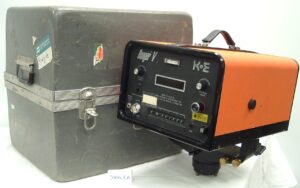
K&E Ranger V. The laser-based Ranger series of EDMs were introduced in 1970 by the Keuffel & Esser Company. It had a self-contained digital computer that made it fully automatic and fast. A 12-volt car battery or motorcycle battery was used for power. In 1982, K&E filed for bankruptcy.
Donated by the Director of Surveys
ALSA 2006.05.06
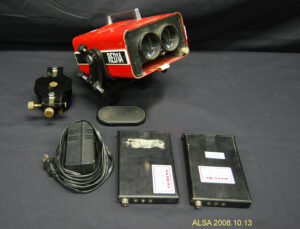
Sokkisha Red1A. The electronic distance meter Red1A was introduced by Sokkisha in 1980. The image shows the Red1A, an adopter for attaching the Red1A to the tribrach on the tripod, a cover for both lens of the unit, a battery charger and two rechargeable batteries. Several other models of Sokkisha Red EDMs followed. In 1990 Sokkisha changed its name to Sokkia. In 2008 Sokkia joined the Topcon Corporation, a world leading supplier of surveying instruments.
Donated by Grant Cross, ALS (Ret.)
ALSA 2008.10.13
Sources of Information
- James Smith Murphy, Electronics Based Innovation in a Niche Market: Distances Measured by the Speed of Light, Thesis submitted to the Graduate Faculty of North Carolina State University, 2004, page 41 and 42: https://repository.lib.ncsu.edu/bitstream/handle/1840.16/961/etd.pdf?sequence=1
- Smithsonian National Museum of American History, Electronic Distance Measurement (EDM): https://amhistory.si.edu/surveying/type.cfm?typeid=7
- The Canadian Surveyor, March 1970, page 47 (Wild D1 10).
- Sokkia/History: https://us.sokkia.com/history
Author: Gordon Olsson, ALS (Hon. Life)
March 24, 2023
Copyright 2024 © Alberta Geomatics Historical Society
